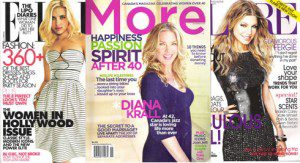Not Older, Better

While other women’s magazine feature 22-year-old celebrities like Scarlett Johansson for their covers, More covers feature 43-year-old Diana Krall
If you scan the glossy covers of women’s magazines on newsstands these days, you’ll see a particular type of woman – young, thin, sexy.
Or maybe a celebrity. Or a model. Or maybe food.
What you won’t see, usually, are middle-aged women staring back at you. More, launched last March, is designed to be something different for consumers of women’s magazines. While Elle, Flare and Fashion target women between the ages of 18 and 34, More directs its attention toward Canadian women over 40. Based on its circulation numbers alone, they seem to be more than happy with the new product.
That More magazine has been a success story straight out of the starting blocks is indisputable. The real question is: how did its staff do it? A good place to start would be More’s editor-in-chief Linda Lewis, who was chosen by owner Transcontinental Media to take the reins of a magazine that immediately filled an unexploited niche in the Canadian marketplace. “I would have gone to More no matter who the owner and publisher was, Rogers or Transcontinental,” says Lewis. “I knew this was a brand magazine.”
“I really believed in what the mandate of this magazine was,” she continues. “And as a 46-year-old woman myself, I can attest that I wanted a magazine that spoke to me.”
After four interviews with Transcontinental executives, Lewis decided to leave her editor-in-chief position atToday’s Parent. In late August 2006, she jumped to More. “I had always wanted to do a launch,” she says. “It’s one of those things that if you ever get the opportunity to do in your career, it’s a fabulous and exciting thing. Scary.”
In September, Lewis helped to organize some focus groups. Women in their 40s and 50s talked about what was important to them, and one of the things that turned out to be important was Canadian content. This consideration was crucial, since Lewis would be in charge of a magazine with an American name.
Lewis then hired one person she had worked with previously; the rest were new. More had not one but two launches. The first was a business trade launch in December 2006, to alert potential advertisers to the new niche market product. The official consumer launch came three months later, in March 2007.
Even success can bring its share of challenges, and the biggest challenge for Lewis so far is keeping up with the pace of growth. Most publishers and editors prefer to wait a couple of years before they have enough confidence in the circulation numbers to prepare an audit statement. Not More — it will turn one in March 2008, yet has already received its first audit statement this month. According to the Audit Bureau of Circulation, its circulation stands at 120,000, with about 100,000 of those paid.
Meredith Corporation, the American owner, originally launched More in 1998 with a circulation of 320,000. Since then the number has almost quadrupled, to 1,200,000. More was named Ad Age Magazine of the Year in 2006 and was listed fourth on Adweek’s “Hot List” this year. Excellent growth and accolades, all in under a decade, but the Canadian More (Meredith agreed to let Transcontinental use the name) has enjoyed an explosive start.
The obvious question is: how? Traditionally, advertisers go after the young, who want to spend money and are in with the latest fashion trends. Following the advertisers, many Canadian women’s magazines go after this age group as well. Chatelaine, for example, Canada’s oldest magazine for women, went fishing for younger readers while trying to keep those who grew up with the magazine.

Linda Lewis, editor of More magazine
But, according to Statistics Canada, there are five million women between the ages of 40 to 59 living in Canada. To reach the female portion of the 40-plus consumers, who control three-quarters of the nation’s wealth, Transcontinental marketed directly to its database of names of women belonging to this demographic. Lisa Rivers,More’s circulation marketing director, says the challenge was, and continues to be, finding good names segmented by age for More’s mailing list.
So while other magazines have been chasing the Holy Grail, the 18- to 34-year-old demographic, and skewing younger editorially, More went the other way from the beginning. It specifically addressed a crowd that has often been ignored by the magazine business: the Baby Boomers. “It’s long overdue,” says Lewis. “In the past few years, readers, marketers and advertisers have woken up to the fact of the power and energy of this group of women.”
Monica Drexler, More’s national sales manager, adds that women aged 40-plus “feel somewhat neglected and insulted — that when you turn 35 you fall off the radar.”
And they’re not going away. According to Statistics Canada, by 2010 this 40-plus age group will be nearly 60 per cent larger than the 18 to 49 audience. Lewis says, “You can’t ignore it anymore.”
More actually celebrates women over 40, boasting that they’re savvy, independent and know what they want. “There’s a lot of power to these women in that target group,” says Drexler, “and advertisers are beginning to understand that.”
That’s why Lewis was careful to select her writers. She made sure they grasped the magazine’s mandate.More aims not to be fluff. The editorial content has a mix of style, body and mind, attitude, people and places, and work and money. In “The Liberation Generation Gap,” for example, published in the November issue, freelance feature writer Jay Teitel offers a male’s outside perspective. “There’s the whole notion of how women were too busy being feminists to raise feminists — too busy being liberated to raise liberated daughters — so what you see now is a backtracking. To an outside observer, this is how it appears.”
Teitel also writes a column on living with a woman going through menopause. “The built-in hook is that you’re a guy writing about women’s issues,” he says. “In the long run I would rather write stuff for women than for men.”
Kim Pittaway, former editor-in-chief of Chatelaine, also freelances for More. In the same issue, she interviews women 40-plus in a department called The Last Time…, where women share stories of the last time they caused themselves harm, used menopause as an excuse, looked into their child’s eyes, wore a bikini or sucked up to their boss. In one reported episode, a woman received a ticket from a police officer for not wearing her seatbelt; she was trying to liberate herself from her coat during a hot flash.
Such articles appear to hit the mark for More readers. “I’m 43 myself,” says Pittaway, “so a lot of the topics and issues that Linda is tackling are exactly on track with where I am in my life.”
After working at Chatelaine and elsewhere, Pittaway believes most magazines aim editorial at the stereotypical 35-year-old spending woman that advertisers want to reach. “We use to get letters fromChatelaine readers all the time who didn’t feel like they were being represented in the pages because we were focusing too much on younger women,” she says. “That’s a chord that More has really struck.”
Jennifer Webb was the Director of Communications for the Summer 2008 issue of the Ryerson Review of Journalism.









































